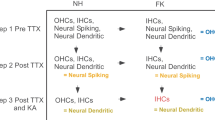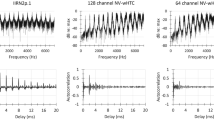Abstract
THE aim of this study is to provide a basic description of the cochlear receptor potentials, the cochlear microphonic (CM) and the summating potential (SP) of the bird. Although several workers have examined these avian potentials in limited aspects, a comprehensive survey of their frequency and intensity behaviour is long overdue. Moreover, a re-examination of the avian potentials has seemed necessary because the potentials are reported to differ vastly from the mammalian CM and SP and one is left with the baffling implication that the middle and/or inner ears of these classes operate with a degree of dissimilarity exceeding what might reasonably be expected on the basis of structural difference. For example, the avian CM sensitivity function has been reported1 to be flatter than the middle ear transfer function in a comparable species2 thus implicating an unknown sort of cochlear element in the frequency response of the avian system. Second, the slopes of avian CM input-output functions have been reported as considerably less than unity and thus less steep than in the mammal1,3–7 leaving unanswered the question of whether the mechanics of the middle ear or basilar membrane, or peculiarities of the receptor cells per se, enforce the nonlinear intensity response in the bird. Third, if, as reported, the avian summating potential is appropriately described as a unitary negative response, manifest only at frequencies above 600 Hz (refs 4, 7–10), one can hardly reconcile this with the observation that the SP exists as both a positive and negative response in the mammal, and certainly occurs at even the lowest audible frequencies11,12 in that class. While each of the above differences implies a fundamental dichotomy between the avian and mammalian cochleae, such differences were not found in the present study. We did however use a new intracochlear electrode configuration in the elucidation of the parametric behaviour of the CM and SP in the pigeon. Fine tungsten electrodes, flame-sealed in capillary tubing, were placed in the basal scala vestibuli (SV) and the scala tympani (ST) proper. This electrode configuration made differential recordings possible and avoided electroanatomical effects, believed to be inherent in previous recessus tympani or round window recordings in the bird. The following differentially measured avian functions are discussed: the 1-µV r.m.s. CM isopotential curve, CM isovelocity curves (relative to a constant footplate velocity of 10−6 mm s−1), CM input–output functions, CM “degree of nonlinearity” functions and SP isovelocity functions. Our results show that these functions do not differ significantly from their mammalian counterparts.
Similar content being viewed by others
References
Wever, E. G., and Bray, C. W., J. comp. Psychol., 22, 353–363 (1960).
Saunders, J. D., and Johnstone, B. M., Acta Oto-lar., 73, 353–361 (1972).
Heise, G., and Rosenblith, W. A., J. comp. Psychol., 45, 401–412 (1952).
Schwartzkopff, J., in Ciba Found. Symp., Hearing Mechanisms in Vertebrates (edit. by de Reuck, A. V. S., and Knight, J.), 41–59 (Churchill, London, 1968).
Schwartzkopff, J., in Basic Mechanisms in Hearing (edit. by Møller, A.), 423–452 (Academic, New York, 1973).
Schwartzkopff, J., in Avian Biology (edit. by Farner, D. S., King, J. R., and Parkes, K. C.), 417–477 (Academic, New York, 1973).
Necker, R., Naturwissenschaften, 56, 143–144 (1969).
Stopp, P. E., and Whitfield, I. C., J. Physiol., Lond., 175, 45–46 (1964).
Necker, R., Verh. Dtsch. Zool. Ges., 64, 178–182 (1970).
Necker, R., Z. Vergl. Physiol., 69, 367–425 (1970).
Davis, H., Deatherage, B., Rosenblut, B., Fernández, C., and Smith, C., Laryngoscope, 68, 596–627 (1958).
Dallos, P., Schoeny, Z. G., and Cheatham, M. A., Acta. Oto-lar. (Suppl. 305), 44 (1972).
Takasaka, T., and Smith, C. A., J. Ultrastruct. Res., 35, 20–65 (1971).
Smith, C. A., and Takasaka, T., in Contributions to Sensory Physiology, 5 (edit. by Neff, W. D.), 129–179 (Academic, New York, 1972).
von Békésy, G., Experiments in Hearing, 745 (McGraw-Hill, New York, 1960).
Weiss, T. F., Peake, W. T., and Sohmer, H., J. Acoust. Soc. Am., 50, 587–601 (1971).
Dallos, P., in Basic Mechanisms of Hearing (edit. by Møller, A.), 335–376 (Academic, New York, 1973).
Dallos, P., Cheatham, M. A., and Ferraro, J., J. Acoust. Soc. Am., 55, 597–605 (1974).
Saunders, J. D., and Dooling, R., Proc. natn. Acad. Sci. U.S.A., 71, 1962–1965 (1974).
Author information
Authors and Affiliations
Rights and permissions
About this article
Cite this article
PIERSON, M., DALLOS, P. Re-examination of avian cochlear potentials. Nature 262, 599–601 (1976). https://doi.org/10.1038/262599a0
Received:
Accepted:
Issue Date:
DOI: https://doi.org/10.1038/262599a0
- Springer Nature Limited
This article is cited by
-
The summating potential polarity encodes the ear health condition
Cellular and Molecular Life Sciences (2023)





